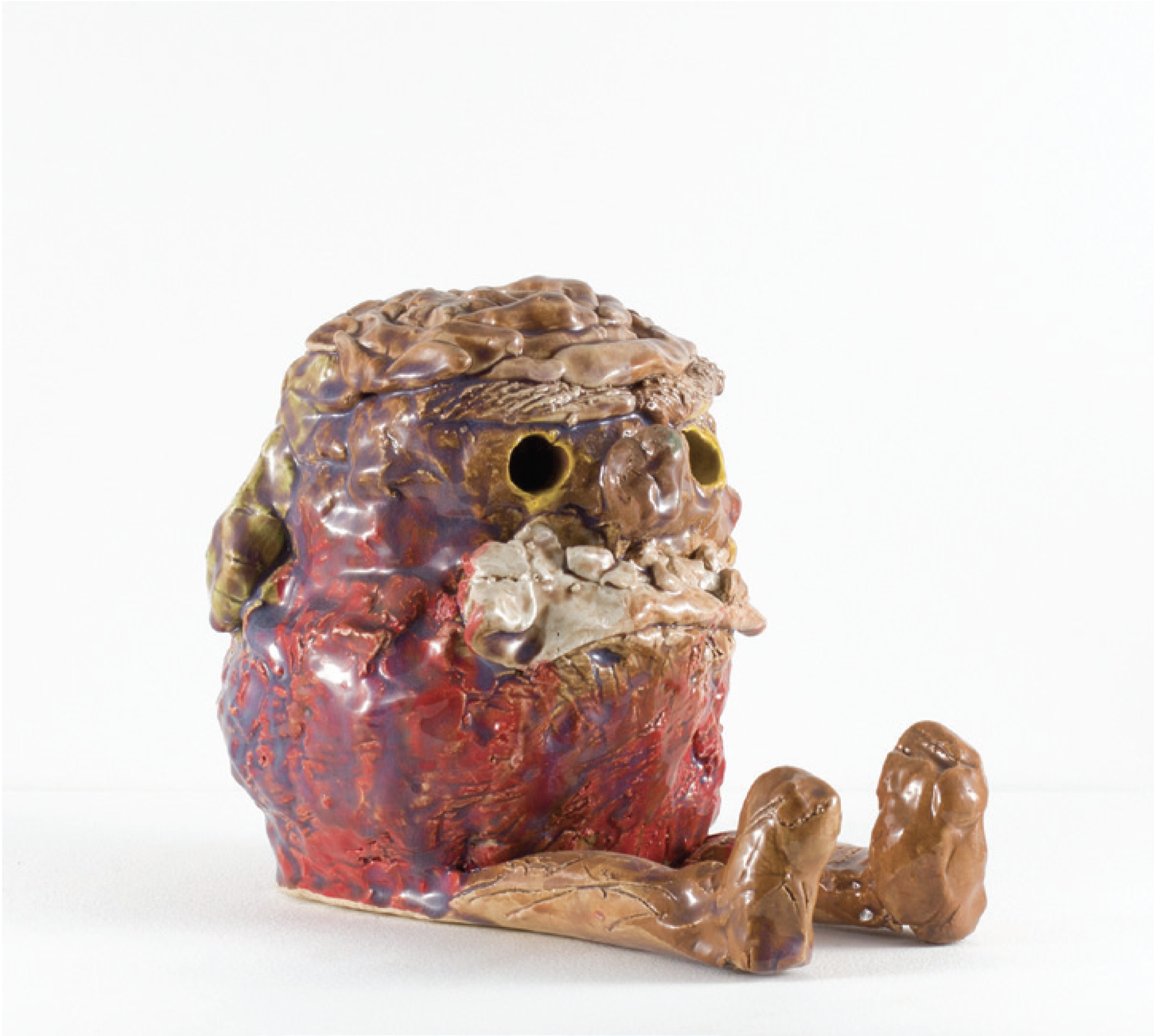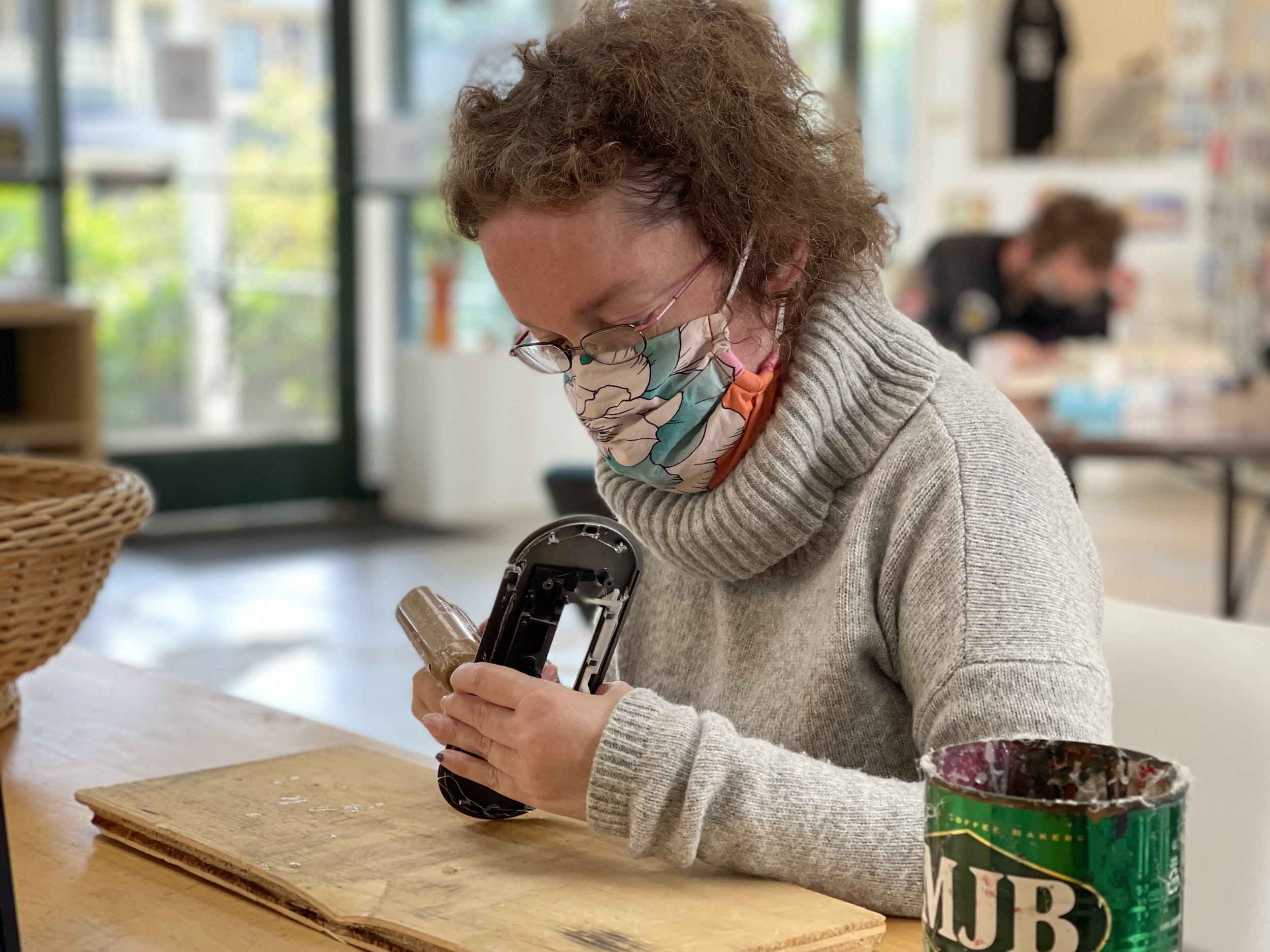Slingshot: A Vision of Ourselves
By Alexandra Terry
Erica Miller started attending the Slingshot / Alpha Art Studio in downtown Santa Barbara in 2015. Though she had no previous experience making art, it quickly became clear that the studio would provide a generative platform for her budding artistic practice to flourish. Seven years later, Miller spends two days a week at the studio devoted to art-making. Her intricate embroidery pieces, humorous and pithy drawings, minimalist scratchboards, and narrative ceramic works are informed by popular culture, featuring recognizable public figures that range from Donald Trump and Universal’s Minions, to Frida Khalo and Hello Kitty. A prolific artist, Miller has no lack of inspiration or ideas. When it comes to turning a critical eye on the talking heads that populate our TV screens every day, she does not hold back; the sarcasm and wit that imbues her art is near tangible.
Founded as an artistic branch of the Alpha Resource Center, Slingshot is a studio and gallery specifically for artists with intellectual and developmental disabilities. Providing space, materials and instruction for over 30 artists at a time, the program takes an individual-centered approach to support each artist in developing an independent and meaningful art practice. The open studio environment is designed to encourage creative expression, and Miller particularly treasures the opportunity to share ideas and artistic approaches with her colleagues. The studio is run by teaching artists, many of whom have graduate degrees or equivalent experience, and is led by a studio manager who has a background in disability advocacy, education and program development. As facilitators, the teaching artists and studio manager track the unique process of each resident artist. By furthering their own understanding of each artist’s intentions, they can more readily provide opportunities for experimentation with materiality and approach.
Slingshot artist Erica Miller
Erica Miller, The Last Dragon, drawing on scratchboard
Leonard Wilson, Arm In Arm, permanent marker on paper
The gallery at Slingshot hosts quarterly exhibitions featuring work made by its resident artists. Gallery Director Jessica Schlobohm, who curated the recent exhibition PoP, started her work at the studio in 2018 as a teaching artist. Following a short hiatus, Schlobohm rejoined in her present capacity with an aim to identify methods that would better serve the artists while broadening the visibility of their work within the community and beyond. She explains, “Art is a form of communication, and so when you’re working with a population that doesn’t have the same access to discourse or speech – whether it is because they are marginalized or non-verbal, as a number of our artists are in varying degrees – it can be an incredible form of expression.”
Alpha Resource Center began its life as Alpha School, founded in Santa Barbara in 1953 by three mothers seeking educational opportunities that were otherwise denied to their children with developmental disabilities. Their vision led to a center that to this day aims to empower individuals with intellectual and developmental disabilities, support their families, and build a community where the contributions of all people are valued. Beginning in the 1980s, Alpha fostered an internal arts program, then called Alpha Art Studio. Operating a few days a week alongside the broader day program activities, the studio was run by members of staff with varying degrees of experience in the arts. Taking inspiration from the studios founded by Florence and Elias Katz in the Bay Area – Creative Growth, Creativity Explored and NIAD (Nurturing Independence through Artistic Development) – Slingshot was established as a discrete program in 2013. The name Slingshot came from resident artist Kim McDaniel (1969–2020), who felt that the program was helping to slingshot the participating artists out into the world to pursue their dreams.
Sparked by the nationwide deinstitutionalization of individuals with disabilities in the early 1970s, artist Florence Katz and psychologist Elias Katz opened Creative Growth in 1974 in Oakland, establishing a model for a creative community guided by the principle that art is fundamental to human expression, and that all people are entitled to its tools of communication. Perhaps the best known of the three art studios founded by the Katzes, Creative Growth has nurtured artists who have gone on to see their work exhibited in museums and galleries nationwide, acquired by estimable special collections, and sold internationally at art fairs in over fourteen countries. One such fair, the Outsider Art Fair, has joined the ranks as an annual must-visit event for art collectors and patrons, attracting big-name curators and blue-chip artists such as Takashi Murakami, who curated the exhibition Super-Rough at the 2021 New York edition of the fair.
Marc Sucher, In Honor to Chris Mars, colored pencil on paper
The term ‘outsider,’ coined by art critic Roger Cardinal in 1972, has been used to describe work made by self-taught artists, or artists who have had little or no contact with mainstream art or art institutions. Cardinal was responsible for translating the writings of Jean Dubuffet, who coined the term ‘art brut’ or raw art, which for Dubuffet included graffiti, the work of the intellectually disabled, prisoners, children and ‘primitive’ artists. What Dubuffet detailed was the raw expression of a vision unrestricted by convention.
Subsequently, the term ‘outsider,’ which has become a catch-all for a type of artistic production that supposedly exists outside of a conscious relationship with ‘traditional’ artistic discourse, has been criticized by many for pushing individuals with disabilities further into the margins. Curators, critics and art historians have struggled to find a term that encompasses this vast and diverse community of artistic production, now tenuously described as ‘progressive’ art. Lynne Cooke, senior curator at the National Gallery of Art, Washington DC, has curated some of the most formidable exhibitions devoted to artists producing work outside of institutions and the Western European art historical canon, contributing to a discourse that criticizes terms such as ‘outsider,’ ‘naïve’ or ‘folk’ as yet another way of discriminating against practitioners working in the margins.
In a lecture on ‘insider’ or ‘self-taught’ art at the Brooklyn Museum (2015), Cook says, “What we need is a re-definition of those relationships where the margins can become, in (author and activist) bell hooks’ words, sites of resistance where an artist might choose to work from the so-called peripheral as a place to contend with some of what’s contained in the center.”
Maria Arroyo, Bloody Mary, acrylic on foam core
It was the Katzes view that studios such as Creative Growth ideally needn’t exist, and that the artists they sought to serve would be provided the same access and respect that able-bodied artists receive. However, in a society where individuals with intellectual and developmental disabilities have been, and still are severely marginalized, it is essential to provide the support necessary for fair and equitable access to the opportunities that any artist would receive.
“The caliber of work that’s been produced (at Slingshot) is on par with other studios across the world. We want to increase the visibility of the artists and their artwork with the appropriate level of professionalism,” Schlobohm says. “Much of the work has broader commercial appeal and the vision of the artists is unique. Art lovers are always looking for unique work.”
Erica Miller is very conscious of her audience, producing art that often includes political undertones intended to impact the viewer. When asked what she loves most about making artwork, she quickly states that there’s nothing she doesn’t like about it. Making art makes her happy, and her work is imbued with a playful sense of joy and observation.
Schlobohm asks that we approach the work produced at Slingshot with respect and curiosity, holding space for what we might not understand, as we would for artwork being produced by any contemporary artist. “(In) seeing the true value of the diversity of vision that comes through the work, (we see) the expression of the world around us,” she says. “Individuals who have been disenfranchised offer a different vantage point and a different way for us to look at ourselves collectively. There is a lot for us all to see about ourselves and how we all process our world in this work.”
PoP, Installation Shot, Slingshot Gallery, 2021; all artwork by Dylan Long, drawings on scratch paper, linocut prints
Cover image: Mark Pasquini, Mr. Face, ceramic
This article was originally published in print in Lum Art Magazine 05.











